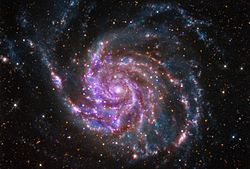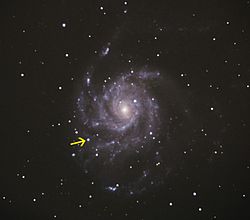Pinwheel galaxy


The Pinwheel galaxy (Messier 101, M101 or NGC 5457) is a face-on unbarred spiral galaxy in the constellation of Ursa Major, the Great Bear.
The galaxy is 21 million light-years (six megaparsecs) away from us.[1] It was first discovered by Pierre Méchain on March 27 1781. Charles Messier verified its position and included it in the Messier Catalogue as one of the last entries.
In 2006, NASA and the ESA released a very detailed image of the Pinwheel Galaxy, which was the largest and most detailed image of a galaxy by the Hubble Space Telescope at the time.[2] The image was composed from 51 individual exposures, plus some extra ground-based photos.
Interesting features
On August 24 2011, a Type Ia supernova, SN 2011fe, was discovered in M101.
A remarkable property of this galaxy are its huge and extremely bright H II regions, of which about 3,000 can be seen on photographs like the Hubble image. H II regions have numbers of short-lived young and massive blue stars formed from clouds of high density molecular hydrogen. These regions give off huge amounts of ultraviolet light that ionizes the surrounding gas.
The galaxy contains ULX-1 (an ultra-luminous X-ray source), which is a relatively small black hole, just 20 to 30 times the mass of our Sun.
Pinwheel Galaxy Media
Dark sky image with some objects around Pinwheel Galaxy (M 101). The quarter in the lower right shows the tail of Ursa Major with the stars Mizar, Alcor and Alkaid.
Type Ia supernova SN 2011fe from August 2011
References
- ↑ Shappee, Benjamin & Stanek, Kris 2011. A new Cepheid distance to the giant spiral M101 based on image subtraction of Hubble Space Telescope/Advanced Camera for Surveys observations. Astrophysical Journal 733 (2): 124. [1]
- ↑ HubbleSite – NewsCenter – Hubble's largest galaxy portrait offers a new high-definition view (02/28/2006) – Introduction


